The U.S. Forest Service anticipates approximately $3.7 million in Great Lakes Restoration Initiative funding will be available for tree planting and restoring native vegetation in the Great Lakes Basin. Continue reading “Great Lakes Restoration Initiative funding available”
Urban Forestry News
Communities encourage planting through tree lists
Communities across the state are reaching out to their citizens and encouraging them to plant trees in their own yards, greening the community with both yard and street trees. The Village of Bayside and the Village of Greenfield are accomplishing this through “Adopt-A-Tree” programs and species lists.
Continue reading “Communities encourage planting through tree lists”
Protect oak trees from oak wilt by waiting until after July to prune
By Don Kissinger, DNR urban forester (Wausau), Don.Kissinger@wisconsin.gov, 715-359-5793 and Paul Cigan, DNR forest health specialist (Hayward), Paul.Cigan@wisconsin.gov, 715-416-4920
To protect oak trees and help prevent oak wilt, the Wisconsin Department of Natural Resources advises people to avoid pruning oaks on their property from April through July.
Spring and early summer pruning makes oak trees vulnerable to oak wilt, a fatal fungal disease that rapidly kills trees in the red oak group and weakens those in the white oak group. Any tree damage during this time creates an opening that exposes live tree tissue and provides an opportunity for the oak wilt fungus to infect the tree.
The red oak group includes northern pin oak, northern red oak, red oak and black oak; the white oak group includes bur oak, swamp white oak, white oak and English oak.
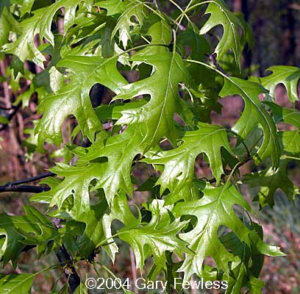
Pin oak (Quercus palustris)
Photo: Gary Fewless, University of Wisconsin, Green Bay
“It takes only a few minutes for beetles that carry oak wilt spores to land on a fresh wound and infect your tree,” said Paul Cigan, DNR forest health specialist in Hayward.
Property owners with oak trees are encouraged to check with their municipality to find out if there are local oak wilt ordinances which may have different pruning restrictions.
The use of tree paint or a wound dressing is not normally recommended on pruning cuts or wounded surfaces on most trees. But for damaged oaks, the use of such products are suggested from April through July. An immediate light painting of wounds or cuts on oak trees during this time helps protect against the spread of oak wilt by beetles.
Don Kissinger, a DNR urban forester in Wausau, said there are also other important reasons to avoid pruning many kinds of deciduous trees in spring beyond concerns about oak wilt.
“Spring is the time when tree buds and leaves are growing, leaving the tree’s food reserves low,” Kissinger said. In general, the best time to prune trees is in winter.
Oak wilt and other diseases move easily on or in firewood logs year-round. To protect trees in general, don’t move firewood long distances, or only use firewood labeled as Wisconsin-certified.
As of January 31, 2018, oak wilt has been found in all Wisconsin counties except Douglas, Bayfield, Ashland, Iron, Forest, Taylor, Door, Kewaunee, Calumet, and Manitowoc counties. Several of these counties contain the highest abundance of healthy and productive oak forests in the state. Taking recommended precautions with living oak trees and keeping firewood local to prevent the spread of oak wilt will help keep them that way for years to come.
More information is available online at the WI DNR website, including a recently released video on oak wilt. Visit the DNR website, https://dnr.wi.gov/, and search for “oak wilt” or “firewood.” Additional information about proper pruning techniques is available from community foresters or by searching for “tree pruning.”
Statewide quarantine for emerald ash borer
By Jodie Ellis, DNR Forest Health Team, communications specialist (Madison), Jodie.Ellis@wisconsin.gov, 608-266-2172
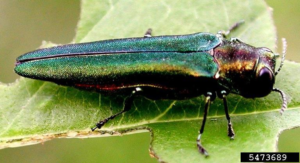
An adult emerald ash borer.
Photo: Leah Bauer, USDA Forest Service Northern Research Station, Bugwood.org
The Wisconsin Department of Agriculture, Trade and Consumer Protection (DATCP) enacted a statewide quarantine for the invasive insect emerald ash borer (EAB) on March 30, 2018. Previously, individual counties were quarantined when EAB was confirmed within each’s borders. Since EAB has been found in 48 of 72 Wisconsin counties, DATCP officials have determined that statewide regulation of the devastating ash tree pest is warranted.
Movement of ash wood, untreated ash products and hardwood firewood of any type to areas outside of Wisconsin will continue to be regulated by USDA’s Animal and Plant Health Inspection Service, Plant Protection and Quarantine. (APHIS PPQ).
Within the state, Wisconsin businesses and members of the public will be able to freely move ash wood, ash products, and hardwood firewood to or from any Wisconsin county. Firewood restrictions will remain in effect on state and federal lands.
Items affected by the statewide EAB quarantine include ash wood with bark attached, larger ash wood chips, and hardwood firewood of any kind. County-by-county quarantines for gypsy moth, another invasive forest pest, remain in effect.
The move to a statewide quarantine does not mean that the state has given up on managing EAB; it is simply a shift in strategy as EAB continues its slow spread through the state. The Wisconsin DNR will continue releasing tiny, stingless wasps -natural enemies of EAB – at appropriate sites, which it has done since 2011. The DNR also continues participation in silvicultural trials in which different ash management strategies are being tested.
Most importantly, campers, tourists, and other members of the public are strongly encouraged to continue taking care when moving firewood within the state. “The actions taken by the Wisconsin public during the last few years have significantly slowed the spread of emerald ash borer and other invasive forest pests in the state,” said Wisconsin DNR EAB program manager Andrea Diss-Torrance. “We can continue to protect the numerous areas within our state that are not yet infested – including those in our own backyards – from tree-killing pests and diseases by following precautions.” Public members should continue to obtain firewood near campgrounds or cabins where they intend to burn it, or buy firewood that bears the DATCP-certified mark, meaning it has been properly seasoned or heat-treated to kill pests.
Emerald ash borer is native to China and probably entered the United States on packing material, showing up first in Michigan in 2002. It was first found in eastern Wisconsin in 2008.
For further information on EAB in Wisconsin, visit https://dnr.wi.gov/ using key words “emerald ash borer.”
Prepare for the return of gypsy moths
By Bill McNee, DNR forest health specialist (Oshkosh), bill.mcnee@wisconsin.gov, 920-360-0942
In a few weeks, gypsy moth egg masses will begin hatching in Wisconsin. Property owners interested in reducing gypsy moth populations should consider oiling or removing reachable egg masses well before the hatch begins. Horticultural oils that suffocate the eggs are available at many garden centers and large retailers. In general, these are applied when temperatures are above 40oF and freezing is not imminent. When physically removing egg masses, scrape them into a can of soapy water and then let them soak for a few days before discarding in the trash in order to kill the eggs. Additional management options for homeowners and woodlot owners are available at the Wisconsin gypsy moth website.
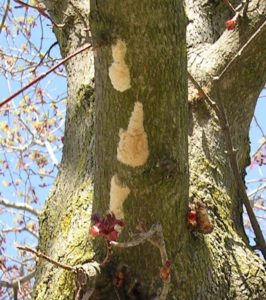
Gypsy moth egg masses
Property owners looking to hire a business to do insecticide treatments this spring should contact them soon. A list of certified arborists is available on the Wisconsin Arborist Association website. Additional businesses offering insecticide treatments may be found in the phone book under ‘Tree Service.’ Homeowners can also purchase insecticides, some of which are applied as soil drenches, at garden centers and large retailers. For larger areas, a list of for-hire aerial applicators is available on the Wisconsin gypsy moth website.
Although this winter’s cold temperatures in late December and early January most likely did not cause heavy egg mortality, the cold period will still help reduce gypsy moth populations this summer. According to the U.S. Forest Service, temperatures of -20°F lasting from 48 to 72 hours can kill exposed eggs. Eggs that are laid higher up on the bark of trees suffer higher mortality than those located near the ground because snow insulates the eggs from cold temperatures. Fluctuating spring temperatures can also cause heavy egg mortality.
2018 suppression spraying:
Dane County will be the only participant in the DNR gypsy moth suppression program in 2018. Aerial spraying will occur in mid- to late May at seven sites in Madison and one site in Sun Prairie. A total of 485 acres will be sprayed with a bacterial insecticide that affects only small caterpillars. Maps of the sites are available on the Wisconsin gypsy moth website.
Slow-The-Spread treatments announced:
The Wisconsin Department of Agriculture, Trade and Consumer Protection (DATCP) announced its planned 2018 Slow-The-Spread (STS) gypsy moth treatments in western counties. About 90,000 acres are scheduled for treatment at 36 sites in 14 counties, using low-flying airplanes. Treatments will begin in May and continue through late July or early August, using either bacterial insecticide or pheromones which cause mating disruption.
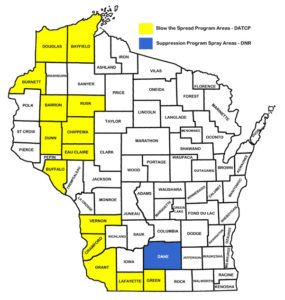
Proposed 2018 gypsy moth treatments will occur in these counties. Counties in yellow are scheduled for Slow-The-Spread (STS) treatments, while Dane County (in blue) will undergo a suppression spray.
Counties scheduled to receive aerial treatments are: Barron (3 sites covering 2,736 acres); Bayfield (1 site, 787 acres); Buffalo (6 sites, 11,754 acres); Burnett (2 sites, 4,529 acres); Chippewa (4 sites, 12,794 acres); Crawford (4 sites, 5,971 acres); Douglas (1 site, 789 acres); Dunn (5 sites, 43,986 acres); Eau Claire (1 site, 674 acres); Grant (1 site, 497 acres); Green (1 site, 392 acres); Lafayette (2 sites, 527 acres); Rusk (1 site, 463 acres); and Vernon (3 sites, 3,785 acres).
More information on STS treatments may be found online at the DATCP Gypsy Moth website.
Treat your valuable ash trees against emerald ash borer (EAB)
By Bill McNee, DNR forest health specialist (Oshkosh), bill.mcnee@wisconsin.gov, 920-360-0942
Wisconsin homeowners with healthy, valuable ash trees should consider treating the trees with insecticides this spring to protect against emerald ash borer (EAB). The pest is currently the most damaging threat to trees in the state, killing more than 99 percent of the ash trees it infests.
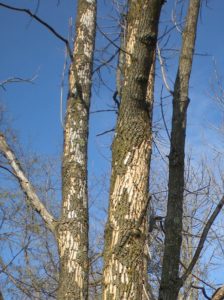
Infested ash trees have been attacked by woodpeckers looking for larvae to eat.
Woodpecker damage during the winter is often the first visible sign that an ash tree is infested, so it is important to examine your ash trees during cold months when leaves are absent. Now is a good time to consider protection with insecticides: insecticide treatments are usually applied between mid-April and mid-May once leaves begin to return. Treatments on already-infested ash trees are more likely to be successful if the trees exhibit only low or moderate levels of woodpecker damage.
Emerald ash borer has become so widespread that homeowners should consider treating valuable ash trees no matter where they are located in Wisconsin. The highest risk of EAB-infestation is within quarantined counties or within 15 miles of a known infestation. Outside of these high-risk areas, the danger of ash trees becoming infested with EAB is probably lower, but it is widely believed that there are additional, undetected EAB infestations within the state. A map of known EAB infestations can be found at the Wisconsin EAB website.
Location isn’t the only consideration when deciding whether to begin insecticide treatments. For example, such treatments are not economically practical for woodlot ash trees; they would need to be repeated every 1-3 years for the rest of the trees’ lives (frequency of treatments will depend on the product and method used).
What you should do
If EAB has been found locally or if you see any of the signs or symptoms of an EAB infestation in your ash trees, search for information online or seek advice from a tree care professional. You can fund a certified arborist at the Wisconsin Arborist Association’s website. Other businesses also conduct EAB treatments.
Some insecticide products can be applied by homeowners but others must be applied by a certified professional. Review the available options before selecting an insecticide and treatment method. Insecticide information can be found on the Wisconsin EAB website and EAB Information Network website.
Only ash trees need to be protected against EAB. Mountain ash and prickly ash trees do not need protection from EAB because they are not true ash trees and are therefore not attacked by the insect.
Consider the following
- Determine whether the tree is worth treating. Some ash trees are too heavily infested to save or have structural or health problems that make them poor candidates for insecticide treatment.
- Trees displaying large amounts of visible woodpecker damage may be too infested to be saved with insecticides. Consult a certified arborist for a professional opinion.
- Landscape trees improve views, increase property values, provide shade and cooling, and contribute to the quality of life in a neighborhood. Weigh those benefits against the expense of a treatment.
- Consider the cost of removing or replacing trees. You might be able to treat your ash tree for more than a decade yet still spend less money than it would cost to remove it.
- The cost of an insecticide treatment will depend on tree size and the product being used. Some products are applied annually; others are applied every two years.
- Check the credentials and insecticide applicator certification of any business you hire to treat your ash trees.
Signs and symptoms of an infestation
Stay informed and be on the lookout for emerald ash borer. Know where the pest has already been found and look for the signs and symptoms of EAB infestation. Watch ash trees closely for the following:
- Woodpecker damage (“flecking”) that looks like pieces of bark have been shaved off and removed;
- Sprouts growing from the base or trunk of the tree;
- Thinning leaves in the upper canopy;
- Tiny (1/8 inch), D-shaped exit holes in the bark; and
- Adult EAB beetles present during the summer.
Be on the lookout for lesser celandine
By Michael Putnam, DNR invasive plants specialist (Madison), Michael.Putnam@wisconsin.gov, 608-266-7596
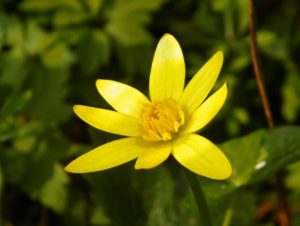
Lesser celandine flower. Photo: Wikimedia
Lesser celandine (Ranunculus ficaria) is an invasive forest plant that been found in urban forests in southeastern Wisconsin. The plant has a history of taking over forest floors in the eastern U. S. and crowding out native plants and tree seedlings. Consequently, lesser celandine is listed as a Prohibited Species under the state’s invasive species law NR 40, and cannot be transported, sold, introduced or possessed in Wisconsin.
DNR is undertaking control projects in Dane, Milwaukee, Racine and Kenosha counties – four of the six counties where lesser celandine is known to occur – and will be conducting surveys in the remaining two counties, Walworth and Waukesha, to inform future control efforts.
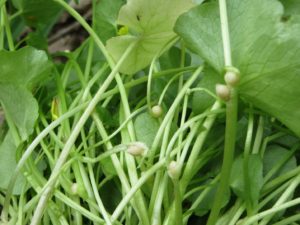
Lesser celandine with reproductive bulbils Photo: DNR photo
Lesser celandine starts growing in early spring, with bright yellow flowers appearing in April. It dies back by the end of June. This low-growing plant has shiny, waxy leaves that are kidney or heart-shaped. Small spherical bulbils that form along the stems drop off to give rise to new plants, while underground tubers sustain the plant after it dies back. Because of its short growing season, DNR depends on reports from the public to identify new populations to plan accordingly. If you encounter this plant, please report it at Invasive.Species@wi.gov.
New oak wilt video released by DNR Forest Health Team
By Paul Cigan, DNR forest health specialist (Hayward), Paul.Cigan@Wisconsin.gov, 715-416-4920
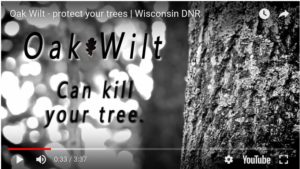
New oak wilt video!
The DNR Forest Health Program just released a new oak wilt video to educate the public about this deadly fungal disease that kills oak trees. In addition to the 3.5 minute video, a 30 second video trailer is also available:, each video may also be accessed from the Wisconsin DNR’s oak wilt webpage.
The videos, which are hosted on YouTube, may be shared through any networks of professional and public contacts who may benefit from viewing this resource. Please post the video on your organizational websites as an additional information source. Promotion of the videos is underway, including print ads in newspapers in several northern counties, DNR Facebook page posts, and an informational flyer distributed in northern counties. If you are interested in distributing flyers, please contact me or Jodie Ellis at Jodie.Ellis@wisconsin.gov for copies. Contact your regional forest health specialist for more details about prevention, detection, and management of oak wilt.
Woodpecker damage is easy to spot during the winter
By Linda Williams, forest health specialist (Woodruff), Linda.Williams@wisconsin.gov, 715-356-5211 x232
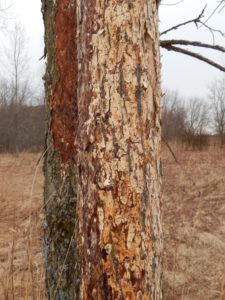
Two elm trees with varying levels of bark stripping caused by woodpeckers feeding on larvae beneath the bark. Photos: Linda Williams
Have you noticed any trees this winter with the bark partially or mostly removed? These trees can stand out dramatically during the winter. Woodpeckers remove outer layers of bark so that they can more easily punch their beaks through the remaining bark to get at the tasty, plump larvae underneath. The three most common trees that you’ll spot this damage on in Wisconsin are elm, tamarack, and ash. So, what’s going on?
On elm, there are three bark beetles of interest. One is a native beetle, and two are exotic species – the smaller European elm bark beetle and the banded elm bark beetle. Adult bark beetles chew their way under bark and lay eggs during the spring or summer. The eggs hatch, and larvae begin feeding in the tree layers under the bark. Going into winter, larvae are plump and delicious (if you’re a woodpecker), and it’s these juicy morsels for which the woodpeckers will strip the outer bark from the tree, sometimes starting at the ground and working all the way to the top. Elm trees will often appear a rich red or burgundy color when outer bark is removed. The U.S. Forest Service offers a document with additional information on elm bark beetles, as well as photos of each of them.

Close-up of tamarack bark, showing the larvae of Eastern bark beetle at the tip of my (broken) knife. Woodpeckers remove the outer bark to make it easier to access these tasty morsels.
Tamarack trees (often referred to as larches) are attacked by a bark beetle as well. Eastern larch beetles attack stressed tamarack trees, although sometimes the stress is so minor that it’s not easily identifiable. The wet weather we had throughout the 2017 growing season definitely stressed some of tamaracks in Wisconsin; having roots in fully saturated soils for too long a period when the tree is actively growing can cause root mortality. Tamarack that have had the outer bark stripped off will appear dark red in color. More information on eastern larch beetle from the U.S. Forest Service can be found here.
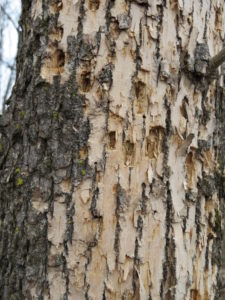
Ash bark with pale areas where woodpeckers have removed outer layers of bark, as well as some small rough holes where the woodpeckers punched through bark and plucked out a nice plump EAB larvae.
Ash trees with the outer bark removed may be infested with either emerald ash borer or a native ash bark beetle. When woodpeckers remove outer bark of an ash tree, it makes the tree look very pale. Emerald ash borer populations build up to very high numbers as they move into new areas, which provides a great source of food for woodpeckers. A study published in 2012 showed that woodpecker numbers can increase due to the presence of EAB.
What about other woodpecker damage that you see on trees?
Pileated woodpeckers are large birds that can do a significant amount of damage to trees. The good news is that they tend to target trees that are dead or have a lot of decay in them. That’s not
to say that they won’t occasionally peck into a healthy tree, but the insects they prefer to feed on are more common in dead or severely stressed trees, or trees with a lot of decay in them. Pileated woodpeckers have tongues containing backward facing barbs that they can stick into an insect gallery to drag out the occupants for a meal. They can leave a pile of good-sized woodchips at the base of trees that they’re feeding in. The photo shows an example of the damage that they can do.
Sapsuckers are birds that drill orderly rows of holes through the bark of trees. The holes go through the bark to the cambial layer, causing the tree to “bleed” sap. Sapsuckers return to feed when the sap is flowing. Sapsuckers’ tongues have little hairs on them to help gather sap. Sapsuckers are migratory and may just pass through an area in the spring, but they will sometimes return to the same tree over multiple years, creating new rows of holes each year. Trees will attempt to grow over this damage, and are usually successful, although the damage to the bark may remain visible for many years. Loggers may note this damage when cutting logs; it is referred to as “bird peck”, and is considered a defect. Federal regulations prohibit people from killing sapsuckers, so control for yard trees is usually some manner of deterrent such as wrapping the main stem with hardware cloth or burlap, or using scare tactics in the tree.
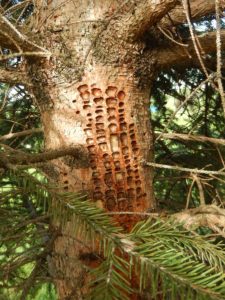
Orderly rows of holes created by yellow-bellied sapsuckers. These birds will revisit these holes that they drill and lick the sap that flows from them.

Damage from pileated woodpeckers can be quite extensive. A single woodpecker can create this level of damage in a few days, or it may work at a tree throughout the season. Note the pile of large woodchips at the base of the tree.
New! Statewide quarantine for emerald ash borer
by Jodie Ellis, Forest Health Team, communications specialist, Jodie.Ellis@wisconsin.gov, 608-266-2172
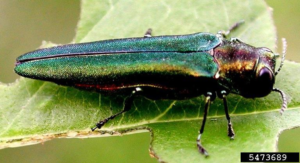
An emerald ash borer adult.
Photo: Leah Bauer, USDA Forest Service Northern Research Station, Bugwood.org
A statewide quarantine of the invasive insect emerald ash borer (EAB) will go into effect on March 30, 2018. Previously, individual counties were quarantined when EAB was confirmed within each’s borders. Since EAB has been found in 48 of 72 Wisconsin counties, officials have determined that statewide regulation of the devastating ash tree pest is warranted.
Movement of ash wood, untreated ash products and hardwood firewood of any type to areas outside of Wisconsin will continue to be regulated by USDA’s Animal and Plant Health Inspection Service, Plant Protection and Quarantine. (APHIS PPQ).
Within the state, Wisconsin businesses and members of the public will be able to freely move ash wood, ash products, and hardwood firewood to or from any Wisconsin county. Firewood restrictions will remain in effect on state and federal lands.
Items affected by the statewide EAB quarantine include ash wood with bark attached, larger ash wood chips, and hardwood firewood of any kind. County-by-county quarantines for gypsy moth, another invasive forest pest, remain in effect.
The move to a statewide quarantine does not mean that the state has given up on managing EAB; it is simply a shift in strategy as EAB continues its slow spread through the state. The Wisconsin DNR will continue releasing tiny, stingless wasps -natural enemies of EAB – at appropriate sites, which it has done since 2011. The DNR also continues participation in silvicultural trials in which different ash management strategies are being tested.
Most importantly, campers, tourists, and other members of the public are strongly encouraged to continue taking care when moving firewood within the state. “The actions taken by the Wisconsin public during the last few years have significantly slowed the spread of emerald ash borer and other invasive forest pests in the state,” said Wisconsin DNR EAB program manager Andrea Diss-Torrance. “We can continue to protect the numerous areas within our state that are not yet infested – including those in our own backyards – from tree-killing pests and diseases by following precautions.” Public members should continue to obtain firewood near campgrounds or cabins where they intend to burn it, or buy firewood that bears the DATCP-certified mark, meaning it has been properly seasoned or heat-treated to kill pests.
Emerald ash borer is native to China and probably entered the United States on packing material, showing up first in Michigan in 2002. It was first found in eastern Wisconsin in 2008.
For further information on EAB in Wisconsin, visit https://dnr.wi.gov/, using key words “emerald ash borer”.
